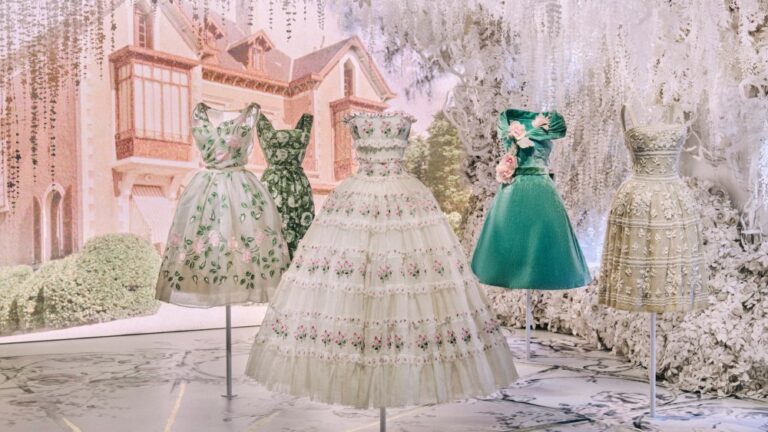PARIS — When a teenaged Azzedine Alaïa first set foot in the hallowed house of Christian Dior, little did he know their names would one day get equal billing.
Alaïa spent only five days in June 1956 as an intern at the Dior haute couture workshops, but he went on to become not only one of the greatest designers of his generation, but also the world’s largest private collector of vintage fashion.
Now La Galerie Dior, the exhibition space at the luxury brand’s historic flagship in Paris, has teamed with the Azzedine Alaïa Foundation to stage a double show highlighting the foundation’s collection of some 600 Dior pieces, of which the majority were designed by the founder.
“This is the first time we’re presenting a collection that isn’t our own,” Olivier Flaviano, head of La Galerie Dior, told WWD during a preview visit. “When we discovered the collection that had been kept secret, we were absolutely amazed — first by the quality, and above all by the fact that there are designs from every year of Dior’s tenure.”
“Azzedine Alaïa’s Dior Collection,” which opens Thursday and is set to run until May 3, features 140 outfits in total, of which three quarters come from Alaïa’s collection.
And from Dec. 15 to May 3, the Azzedine Alaïa Foundation will showcase 30 Dior creations collected by Alaïa alongside a similar number of his own, as part of its ongoing series of exhibitions demonstrating how the French couturier of Tunisian origin was influenced by the designers he admired.
Both shows are curated by Olivier Saillard, director of the Azzedine Alaïa Foundation, in collaboration with archivist Gaël Mamine, who worked with the teams at Dior Heritage to catalog the collection. Each dress was identified, with the house sourcing dozens of related documents, from sketches to press clippings.
“Not one of these pieces has been shown until now, and we also wanted to highlight all the behind-the-scenes digging that Dior Heritage carried out to document everything,” Saillard said. “This allows a student, or anyone unfamiliar with fashion, to understand that it’s not just an art: it’s a science.”
Among the documents on show is the original employee card from Alaïa’s brief stint at the house. “Dior was still alive. They could have crossed paths,” Saillard noted. Poignantly, the exhibition will open just two days after the eighth anniversary of Alaïa’s death.
“This collection returning here is such a symbol of hope, showing that anything is possible. Azzedine came from a poor background and became one of the greatest fashion designers. He was here for only five days, yet that was enough to inspire boundless admiration. The proof is this collection, which is truly worthy of a museum,” he said.
Indeed, the Alaïa Foundation is applying to be registered as a museum, a lengthy procedure under French law, Saillard revealed.
Alaïa’s collection got its first major show in 2023 at the Palais Galliera, the Paris fashion museum that Saillard headed from 2010 to early 2018. Dior has previously worked with the fashion historian on books, including a series of coffee-table tomes from Assouline chronicling each creative director of the brand.
Alaïa was known for collecting designs that mirrored his own passion for structured, exacting tailoring, and there are plenty of examples in this show, which reflects Dior’s architectural approach to design.
“I have no wish to deprive fashion (and the ladies) of the added allure and charm of color, but I could perfectly well design a whole collection simply in black or white,” the couturier is quoted as saying in the exhibition catalog published by Rizzoli.
A row of gray and black designs illustrates how Dior even named his collections after geometric shapes and letters, from his Ligne Ailée for fall 1948 to the Ligne Fuseau of his last collection in 1957. Facing the clothes is a wall filled with his original sketches and press releases providing an insight into his skill for communication.
“This is the first time we have shown so many original sketches by Monsieur Dior,” said Flaviano. “When Mr. Dior created a collection, he would draw between 600 and 800 sketches, narrow them down to about 200 that would be made into toiles, and ultimately present a show of around 180 models.”
There are conceptual designs like the Patchouli dress, a contemporary of the Cigale, whose cage-like construction was a key inspiration for Jonathan Anderson’s debut collections for the house this year. Minimal designs like the Surprise tunic signal why Dior has inspired Japanese designers, including Yohji Yamamoto.
“I really wanted to make a connection to architecture, because Azzedine always said that as a teenager in Tunis, when he looked at fashion magazines, he was fascinated by Dior dresses that seemed to stand on their own. He always wanted to uncover that mystery — the hidden architecture within the dresses,” Saillard said.
More surprisingly, Alaïa was also sensitive to the romantic side of Dior, collecting gowns bursting with floral patterns, embroidery and vivid color.
A room showcasing nip-waisted dresses in bright lipstick shades is lined with collection boards pinned with fabric swatches that show leopard print and polka dots were part of Dior’s repertoire from his debut collection in 1947, which famously launched the New Look.
Saillard said that if he had to pick a single dress, it would be the strapless Fête au Village model from spring 1955 with delicate floral embroidery.
“It’s so fresh, so radiant, so delicate in its treatment of flowers and light, airy fabrics,” he enthused. “It captures Dior perfectly: something that makes you smile, that is perfectly delicate. It shows real consideration for women. I think it goes beyond fashion.”

